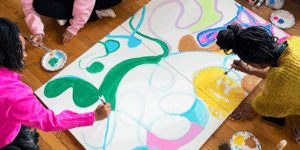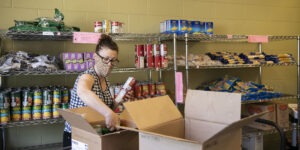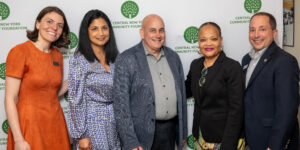DONATIONS FROM HEARTS & WALLETS
As the Community Foundation and its partners discussed how to respond to COVID-19, Tom Griffith experienced moments of doubt about the funds’ success. “Will this work?” Griffith, vice president of development, remembers thinking. “There’s a lot of uncertainty. People are stretched. Are they going to be able or willing to give to this?”
Within a week of announcing the COVID-19 Community Support Fund, an anonymous $250,000 gift came in. So did $5 and $10 donations. Generous and heartfelt contributions came in for the regional and affiliate funds as well. Griffith’s doubt disappeared.
Transparency, collaboration among community funding partners and a clear plan to fund essential needs set the tone for the project. “People understood that this was important,” Griffith said. “They understood that people were without basic essentials. People wanted to help others who were thrust into a place of need by this crisis.”
In Onondaga County, donations came from the fund’s founding partners, individuals and corporations, donor-advised fundholders and foundations.
The smallest donation was $1; more than 300 donations were less than $100. Many of the 779 individual gifts came from Community Foundation and United Way donors; 170 were anonymous. “Donations came from every part of our community,” Griffith said.
Six individuals donated their $1,200 federal stimulus payments.
A $250 donation came with the explanation that it was “part of the stimulus check that I don’t need.” A $500 donor explained their daughter tutors Syracuse students and worried how the crisis affected them.
“Together we’ll stay strong,” read one note. “In memory of my father, who was always ready to help others,” read another.
About 50 Community Foundation donor-advised fundholders transferred money to the COVID-19 fund.
The Waldman family, for example, donated in hopes the crisis would strengthen Central New York’s sense of community. The Waldman children held an online art auction to raise money.
“With lots of uncertainty, we felt giving would add stability for others affected by this crisis,” they said.
The Borer family created a LemonAID stand to help their children raise money for the fund and matched the stand’s proceeds with a donation from their donor-advised fund at the Community Foundation. The family wanted to help healthcare workers — a relative works as a doctor in New York City — teachers, and local businesses.
“The kids did all the work and we were absolutely humbled by the generosity of family, friends and neighbors to support us and help us make a difference,” they said.
Other groups found creative ways to support the fund.
When Syracuse University sent students home in March because of the pandemic, sorority members sought a way to maintain their philanthropic traditions without in-person events. Thirteen sorority chapters of the university’s Panhellenic Council — made up of many students who live outside Central New York — raised more than $5,700 through a virtual fundraising competition. “We knew that we would need to team up to make the biggest impact on our Syracuse community,” said Nicole Jaskot, the council’s director of philanthropic events.
The Fayetteville-Manlius High School Model United Nations Club raised $2,500. Sea Culture clothing store in Skaneateles donated a percentage of its sales. Another community member set up a birthday fundraiser.
Facebook Live concerts also raised money. On March 25, Corey Paige, a SAMMY Award-winning singer, songwriter and Syracuse musician, performed for an hour as 2,500 people viewed the virtual concert and sent in online donations.
Generosity, creativity and empathy spurred these contributions to assist Central New York during the COVID-19 crisis.
As of July 31, more than $2.2 million was raised and 142 grants were distributed totaling nearly $1.8 million across all of the COVID-19 support funds.
“The relentless daily outreach to give has been incredibly inspiring,” Griffith said. “People responded to this fund with more than just their wallets.”









